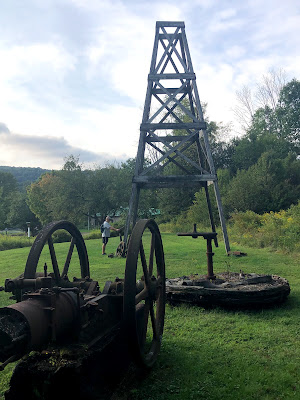As usual, Beth's diligent research led us to another nice destination. She had read about Oil Creek State Park. It sounded nice and one of the friendly neighbors we talk to frequently confirmed it was a great place to visit. We loaded the bikes into the back of the CR-V and made the short trek (18 miles) up the road, and if only in our minds, back in time.
Visiting Oil Creek State Park on a sunny, peaceful and somewhat unseasonably warm September afternoon was quite a contrast from what the area must have looked, sounded and smelled like back in the 1860's. The 6,250 acre state park was established in 1931 and continues to honor the areas past and it's connection to oil.
In the 1850's the area was reported to be a "sleepy, slow growing" area with lumber being the primary industry. Oil was known to exist in the area but a technique to extract it had not been developed. Everything changed near the end of 1859 when the first successful oil well was drilled in the area. Word spread quickly and soon the rush was on. Fortune seekers made their way to the area to drill and stake their claims to "liquid gold".
The "sleepy, slow growing" area suddenly became a bustling hub of activity. A really interesting informational boardwalk in the park tells the story of the transformation of the area. Clapboard houses, hotels, stores, bars, banks and theaters popped up everywhere along the river valley. The buildings were built quickly and haphazardly. Many of them went down almost as fast as they went up when a random spark would suddenly become a major blaze. As soon as the last embers were extinguished, rebuilding would begin. Additionally, as the speculators would move from one location to another buildings would be torn down, moved and rebuilt.
Like the California Gold Rush, the Pennsylvania Oil Rush attracted many hard living, colorful characters. Those who made money frequently made lots of it and there was plenty of saloons, gambling houses and brothels to help those who had struck it rich find a way to spend their money. There were legendary stories such as one about a fella who struck it rich and proceeded to drink himself to death. As he lay dying his last words were "tell them to drink water". There was also Samuel Wood who lost his entire fortune on a single roll of the dice. He rolled a nine, but his competitor rolled an eleven. Not to be left out, women got in on the “action”. The most famous was probably "French Kate", the owner and proprietor of many of the finest brothels in the area. It is rumored that at some point somewhere in her career John Wilkes Booth, the assassin of President Lincoln had been one of her many "clients".
Even in the best of times, as you could imagine, the living and working conditions for both humans and animals were less than desirable. It was said that as soon as a new arrival would step off the train platform that they would be greeted with mud that was often knee deep and that the smell of oil was thick and always present. Animals, particularly horses labored long and hard to pull heavy sleds loaded with barrels of oil up the icy waters of oil creek.
A lot has changed since those days, but thankfully the stories have been nicely captured. If you ever visit Oil Creek State Park stop at the train station and devote a little time to following the board walk and read the stories of the past and try to imagine what it must have truly been like in those days. It's kind of nutty and chaotic right now but given the choice of living in the present or being an oil speculator in the early 1860's, I think I'll stick with today.







